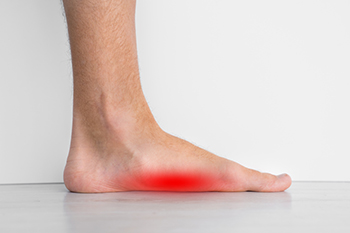
Flat feet, or fallen arches, occur when the arch of the foot collapses, leading to the entire foot making contact with the ground. Symptoms can include foot pain, swelling, and difficulty standing for long periods of time. Causes can range from genetic factors to injury or conditions such as arthritis. In children, flat feet are often a normal part of development, usually improving with age. However, if persistent, they may require intervention. In adults, flat feet can result from wear and tear, obesity, or excessive strain. Both children and adults may experience discomfort or difficulty in activities. Treatment options include wearing supportive footwear, using orthotics, and doing exercises to strengthen the foot muscles. If you or your child has flat feet, it is suggested that a podiatrist is consulted and regular visits are scheduled to help manage this condition.
Flatfoot is a condition many people suffer from. If you have flat feet, contact one of our podiatrists from North Penn Podiatry. Our doctors will treat your foot and ankle needs.
What Are Flat Feet?
Flatfoot is a condition in which the arch of the foot is depressed and the sole of the foot is almost completely in contact with the ground. About 20-30% of the population generally has flat feet because their arches never formed during growth.
Conditions & Problems:
Having flat feet makes it difficult to run or walk because of the stress placed on the ankles.
Alignment – The general alignment of your legs can be disrupted, because the ankles move inward which can cause major discomfort.
Knees – If you have complications with your knees, flat feet can be a contributor to arthritis in that area.
Symptoms
- Pain around the heel or arch area
- Trouble standing on the tip toe
- Swelling around the inside of the ankle
- Flat look to one or both feet
- Having your shoes feel uneven when worn
Treatment
If you are experiencing pain and stress on the foot you may weaken the posterior tibial tendon, which runs around the inside of the ankle.
If you have any questions please feel free to contact our offices located in Lansdale, and King of Prussia, PA . We offer the newest diagnostic and treatment technologies for all your foot and ankle needs.
